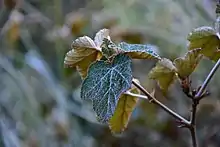| Rubus formosensis | |
|---|---|
.jpg.webp) | |
| Potted specimen | |
 | |
| Adaxial surfaces of leaves are rugose[1] | |
| Scientific classification | |
| Kingdom: | Plantae |
| Clade: | Tracheophytes |
| Clade: | Angiosperms |
| Clade: | Eudicots |
| Clade: | Rosids |
| Order: | Rosales |
| Family: | Rosaceae |
| Genus: | Rubus |
| Species: | R. formosensis |
| Binomial name | |
| Rubus formosensis | |
| Synonyms[2] | |
| |
Rubus formosensis, the Formosan raspberry or Formosan bramble, is a species of flowering plant in the family Rosaceae, native to southeastern China (Guangdong and Guangxi), and Taiwan.[2][3][4] It is found at a wide range of elevations, generally in habitats that have limited competition from other plants.[1] A thornless shrub with a restrained climbing habit, reaching at most 2 m (7 ft), and with attractive evergreen leaves, it is available from commercial suppliers.[3][5]
References
- 1 2 "台湾悬钩子 tai wan xuan gou zi". Flora of China. efloras.org. 2023. Retrieved 3 September 2023.
- 1 2 "Rubus formosensis Kuntze". Plants of the World Online. Royal Botanic Gardens, Kew. Retrieved 3 September 2023.
- ↑ Yen, Shih-Ching; Lin, Chung-Yi; Hew, Shun Win; Yang, Shu-Yi; Yeh, Chuan-Feng; Weng, Guo-Jing (2015). "Characterization of Debarking Behavior by Sambar Deer (Rusa unicolor) in Taiwan". Mammal Study. 40 (3): 167–179. doi:10.3106/041.040.0304. S2CID 86254930.
- ↑ "Rubus formosensis". The Royal Horticultural Society. 2023. Retrieved 3 September 2023.
4 suppliers
This article is issued from Wikipedia. The text is licensed under Creative Commons - Attribution - Sharealike. Additional terms may apply for the media files.